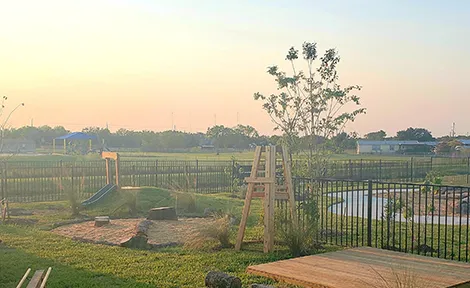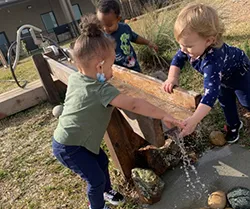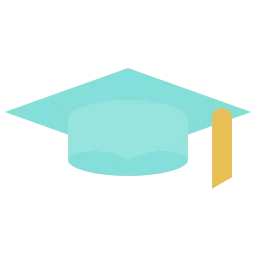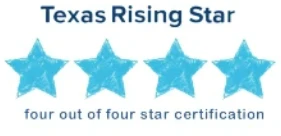Natural Playgrounds – What is it and Why?

Traditional playgrounds closed across the country for months due to COVID-19. As a result, more families have explored the outdoors, using the natural environment as their playground. Jumping on logs, drawing in the dirt, and arranging rocks are all ways in which children play in nature. Play and learning go hand in hand, especially in early childhood development. So how do you get the most learning out of play? Natural playgrounds.
Director Holly Barber-Gatlin has a certification in Early Childhood Outdoor Learning Environments and brought in her colleague, Audrey Rowland, owner of Greenspace Learning and Development. Audrey and her team helped design a custom natural playground for the children at The LUX School to enjoy.
Natural Playgrounds
Natural playgrounds utilize nature and natural materials to create an engaging and open-ended play environment which provides children the opportunity to explore, move, and learn. While typical playground structures are fun and inviting, they can become uninteresting over time and provide little in the way of development beyond gross motor skills. Natural playgrounds have open areas rich with space and natural structures highly conducive to the gross motor development of young children where they can run, climb, balance, roll, pull, push, etc.
Safe Play Spaces
In order to be deemed safe for play, these environments typically have common elements such as: eliminated hazards (sanded wooded, removed choking hazards, reduced hill size for minimal fall zones), sensory and loose part play that is developmentally appropriate (play areas are divided based on age ranges, fall risks and gross motor abilities), and contain varied engagement areas (music, construction, art, and water play). Natural playgrounds offer opportunities for less confinement (social distance), communication, problem solving, creativity, physical and sensory development.
Collaboration
Collaboration and cooperation are valued skills and their growth extends beyond the classroom but is rarely seen in traditional play areas. The natural playground environment produces situations where children learn to request the help of others and take part in supporting fellow students in need.
Imagination
When playing in a natural playground, children can create endless “scenes” using their imagination. Their cognitive abilities are stretched through repeated exercises of problem solving, communication tasks and ingenuity. On a natural playground, play is directed by the child, not the structure.
Natural Support
Educators play a critical role in natural playgrounds, not by directing play or limiting activity but by providing active supervision. Safety is a top priority at The LUX School. Outdoor play areas are no different, with the toddler areas utilizing smaller climbing options and larger loose parts. As children grow and discover what they are capable of, they will be supported in their exploration of their environment under the supervision of a staff well-trained in child development best practices.
Giving children the tools (in this case, nature) to broaden their horizons cultivates imagination, growth, and forward thinking, the “stepping stones” of learning.
For any questions or information on enrollment at The LUX School, please contact registrar@theluxschool.com.
 Notices
Notices
 Enrollment
Enrollment
Accepting students ages 6 weeks to 12 years. Enroll Today!
 Hours of Operation
Hours of Operation
Monday through Friday
6:00 AM – 6:30 PM
 Location
Location
 Payment Options
Payment Options
![]()
![]()
![]()
CHECK/ACH MONEY ORDER
We Love The LUX School
Schedule a Tour Today to Find Out More!
Why the LUX School?
We care about the education of young children in our community. We collaborate with parents to balance the care and scholastic needs of their children. We change by offering educational opportunities for early childhood employees that seek enrichment.
Copyright © 2021 The LUX School
Powered By: EvolveTheBrand.com

 1-833-LUX-KIDS
1-833-LUX-KIDS





